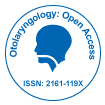Robotic-Assisted Surgery in Otolaryngology: Enhancing Precision and Patient Outcomes
Received: 30-Dec-2024 / Manuscript No. ocr-25-161366 / Editor assigned: 02-Jan-2025 / PreQC No. ocr-25-161366 / Reviewed: 18-Jan-2025 / QC No. ocr-25-161366(QC) / Revised: 22-Jan-2025 / Manuscript No. ocr-25-161366(R) / Published Date: 30-Jan-2025 DOI: 10.4172/2161-119X.1000620
Abstract
Robotic-assisted surgery (RAS) has emerged as a transformative tool in otolaryngology, offering enhanced precision, reduced invasiveness, and improved patient outcomes. This paper explores the evolution, advantages, and challenges of robotic-assisted surgery in otolaryngology, with a focus on transoral robotic surgery (TORS) and robotic-assisted sinus and skull base procedures. Through an analysis of clinical outcomes, surgical efficiency, and future prospects, this research highlights how RAS is revolutionizing otolaryngologic procedures. Challenges such as cost, accessibility, and training requirements are also discussed. The integration of artificial intelligence (AI) and machine learning in robotic surgery is anticipated to further refine surgical techniques and optimize patient care.
Introduction
Otolaryngology, or ear, nose, and throat (ENT) surgery, encompasses a broad range of procedures addressing conditions of the head and neck. The advent of robotic-assisted surgery (RAS) has significantly impacted this field by enhancing surgical precision, reducing recovery times, and minimizing complications. Initially developed for urological and general surgery, robotic-assisted platforms such as the da Vinci Surgical System have now been adapted for use in otolaryngologic procedures, particularly in transoral robotic surgery (TORS) for oropharyngeal cancers and robotic-assisted procedures for sinus and skull base pathologies.
The need for minimally invasive techniques has driven the adoption of RAS in ENT surgery. Traditional open surgeries often lead to extensive tissue damage, prolonged hospital stays, and increased risk of complications. In contrast, robotic-assisted procedures allow for enhanced dexterity, three-dimensional visualization, and improved access to anatomically challenging regions. This paper examines the current applications, benefits, and limitations of RAS in otolaryngology and explores its future potential in improving surgical outcomes [1,2].
Discussion
TORS has revolutionized the treatment of oropharyngeal malignancies, obstructive sleep apnea (OSA), and benign tumors of the throat. Using robotic platforms, surgeons can access deep-seated areas of the oropharynx and larynx with enhanced precision and minimal collateral damage. Studies have shown that TORS results in reduced operative time, lower morbidity, and improved functional outcomes, such as better swallowing and speech preservation, compared to conventional surgery.
Robotic-assisted techniques are increasingly being used for sinus and skull base surgeries, particularly for resecting tumors in hard-to-reach areas. The precision of robotic arms allows for meticulous dissection near critical structures such as the optic nerve and carotid artery, reducing the risk of complications. Additionally, robotic platforms enable endoscopic visualization, facilitating minimally invasive approaches to complex pathologies.
Although still in its nascent stages, robotic-assisted surgery is being explored in pediatric otolaryngology for congenital airway anomalies and other intricate procedures. The ability to perform delicate surgeries in small anatomical spaces presents promising opportunities for improved pediatric patient care.
The future of robotic-assisted surgery in otolaryngology is promising, with ongoing advancements aimed at overcoming current limitations. The integration of artificial intelligence (AI) and machine learning is expected to enhance intraoperative decision-making, improve precision, and facilitate real-time adjustments. Additionally, the development of more compact and cost-effective robotic systems will likely increase accessibility and affordability.
Furthermore, telesurgery and remote robotic-assisted procedures are emerging as potential innovations that could allow expert surgeons to operate on patients in distant locations, thereby addressing geographical barriers to specialized surgical care [2-5].
Conclusion
Robotic-assisted surgery has significantly advanced the field of otolaryngology, offering numerous benefits such as enhanced precision, reduced invasiveness, and improved patient outcomes. While challenges such as cost, training requirements, and accessibility persist, ongoing technological advancements are expected to address these limitations and expand the role of robotics in ENT surgery. The continued integration of AI and machine learning holds great potential for refining robotic-assisted techniques and further optimizing patient care. As research and innovation progress, robotic-assisted surgery is set to become a mainstay in modern otolaryngologic practice, revolutionizing the surgical landscape and improving overall healthcare outcomes.
Acknowledgment
None
Conflict of Interest
None
References
- Nybo H, Petersen HC, Gaist D, Jeune B, Andersen K, et al. (2003) Predictors of mortality in 2,249 nonagenarians—the Danish 1905-Cohort Survey. J Am Geriatr Soc 51: 1365–1373.
- von Heideken Wågert P, Rönnmark B, Rosendahl E, Lundin-Olsson L, M C Gustavsson J, et al. (2005) Morale in the oldest old: the Umeå 85+ study. Age Ageing 34: 249-255.
- Andersen HR, Jeune B, Nybo H, Nielsen JB, Andersen-Ranberg K, et al. (1998) Low activity of superoxide dismutase and high activity of glutathione reductase in erythrocytes from centenarians. Age Ageing 27: 643-648.
- Ankri J, Poupard M (2003) Prevalence and incidence of dementia among the very old. Review of the literature. Rev Epidemiol Sante Publique 51: 349-360.
- Wilkinson TJ, Sainsbury R (1998) The association between mortality, morbidity and age in New Zealand’s oldest old. Int J Aging Hum Dev 46: 333-343.
Indexed at, Google Scholar, Crossref
Indexed at, Google Scholar, Crossref
Indexed at, Google Scholar, Crossref
Citation: Andrew B (2025) Robotic-Assisted Surgery in Otolaryngology: Enhancing Precision and Patient Outcomes. Otolaryngol (Sunnyvale) 15: 620. DOI: 10.4172/2161-119X.1000620
Copyright: © 2025 Andrew B. This is an open-access article distributed under the terms of the Creative Commons Attribution License, which permits unrestricted use, distribution, and reproduction in any medium, provided the original author and source are credited.
Select your language of interest to view the total content in your interested language
Share This Article
Recommended Journals
Open Access Journals
Article Tools
Article Usage
- Total views: 737
- [From(publication date): 0-0 - Dec 21, 2025]
- Breakdown by view type
- HTML page views: 584
- PDF downloads: 153
